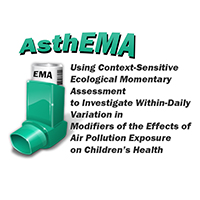
Using Context-Sensitive Ecological Momentary Assessment to Investigate Within-Daily Variation in Modifiers of the Effects of Air Pollution Exposure on Children’s Health
Funded by National Institute on Environmental Health Science P30ES07048
(Dunton, PI on pilot study)
Understanding the effects of traffic and air pollution on childhood asthma and obesity has been an important objective of research conducted by the Southern California Environmental Health Science Center (SCEHSC). A growing area of interest is the effect of psychosocial and behavioral factors such as stress and physical activity in modifying these relationships. In large epidemiological studies, physical activity, stress, exposure to air pollution, and asthma are typically assessed annually. Although this measurement approach can capture change over longer periods of time, the effects of day-to-day and within-daily variation in key exposures is unknown. Preliminary research suggests that activity levels, stress, and air quality vary considerably across each day. These time-varying factors may act independently or interact with each other to predict the onset of asthma episodes. To date, methods of capturing within-daily covariation in environmental exposures related to asthma have been limited. However, advances in mobile phone technologies have created opportunities for real-time exposure assessment. Common smartphones are capable of running applications that, measure body movement, indicate geographic location, trigger electronic surveys, and integrate input from other portable sensors. The proposed study will develop and test an ambulatory real-time data capture system using mobile phone technology to investigate within-daily covariation in air pollution exposure, physical activity, stress, and asthma symptoms in children.
The project used Context-Sensitive Ecological Momentary Assessment (CS-EMA), a data collection strategy in which information obtained from the phone’s internal sensors such as the accelerometer and global positioning system (GPS) and external exposure sensors (measuring nitrogen dioxide, ozone, and inhalant use) will trigger real-time self-report questions on the mobile phone assessing the child’s current activity, context, mood, stress, and asthma symptoms. The real-time assessment methods developed in this pilot study can be deployed in large scale epidemiological and intervention studies on air pollution exposure and children’s health.